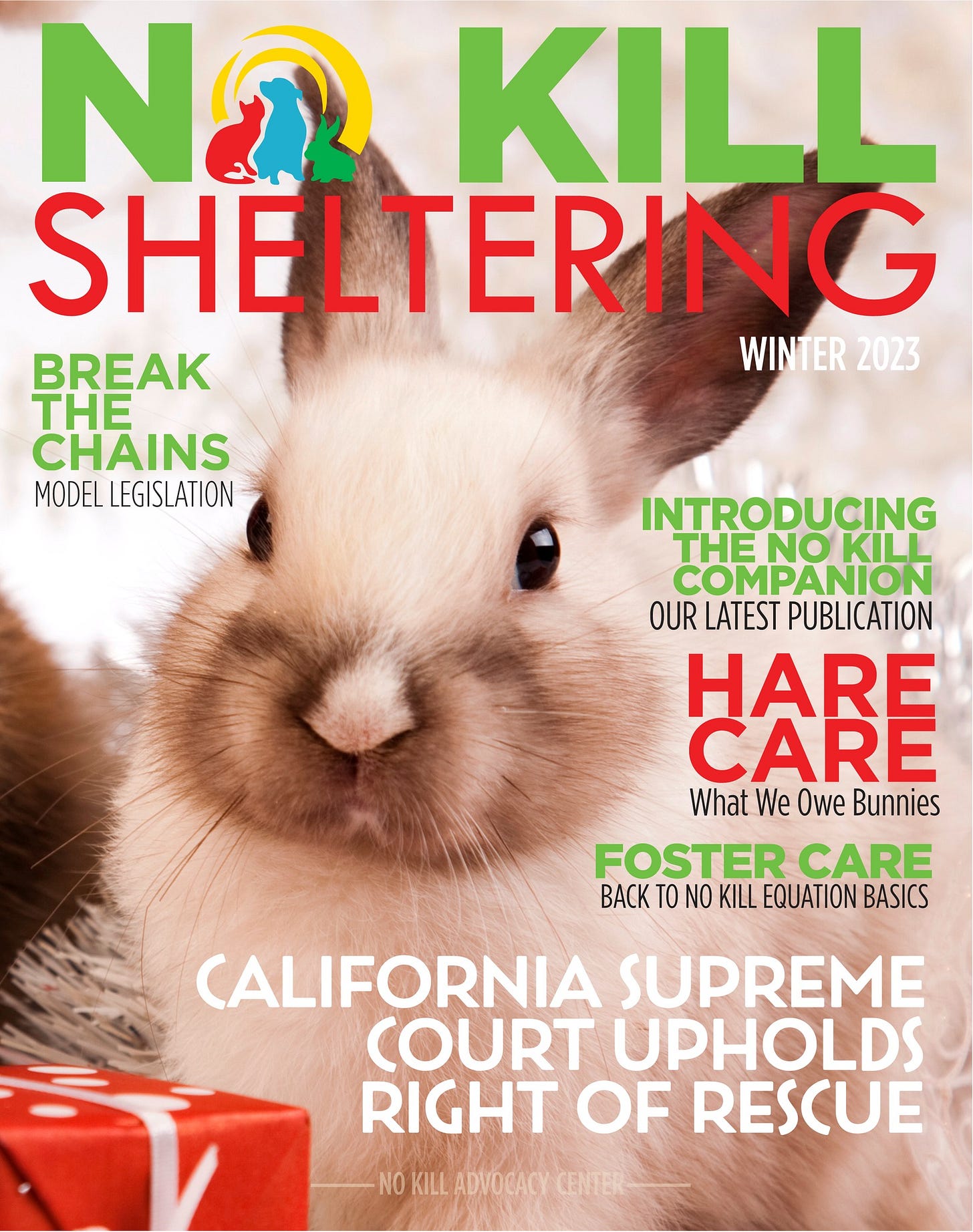The fate of thousands of animals is in our hands

The Colorado Rescue Act (House Bill 24-1114) would require Colorado shelters to notify qualified and licensed rescue organizations and No Kill shelters before killing an animal. And given that such notifications are possible through shelter software already used by these facilities or available for free, complying would require nothing more than a stroke on a keyboard: one click to notify rescuers that a life needs saving.
House Bill 24-1114 is such a simple, commonsense law it is astonishing that anyone would oppose it. But it is being opposed by Colorado pounds that kill thousands of animals every year, despite rescue organizations ready, willing, and able to save them. They argue that their decisions to kill animals should not be questioned.
The bill has been assigned to the House Agriculture, Water & Natural Resources Committee. To overcome the opposition of regressive “shelters” and their allies, we need large numbers of animal lovers to urge committee members to vote “YES” on HB 24-1114.
A “YES” vote is a vote to save the lives of animals scheduled to be killed.
A “NO” is a vote to allow “shelters” to continue to kill them in secret, even though they have a place to go.
We have made it easy for you. All you need to do is cut and paste the To, Subject, and Body text below to an email.
To:
karen.mccormick.house@coleg.gov, julia.marvin.house@coleg.gov, tammy.story.house@coleg.gov, ty.winter.house@coleg.gov, marc.catlin.house@coleg.gov, meghan.lukens.house@coleg.gov, barbara.mclachlan.house@coleg.gov, brianna.titone.house@coleg.gov, richard.holtorf.house@coleg.gov, matthew.martinez.house@coleg.gov, matthew.soper.house@coleg.gov, elizabeth.velasco.house@coleg.gov, Alexa.Kelly@coleg.gov
Subject:
YES on House Bill 24-1114 (Colorado Rescue Act)
Body:
Please vote YES vote on House Bill 24-1114. The Colorado Rescue Act would require shelters to notify licensed rescue organizations and No Kill shelters before killing an animal. And given that such notifications are possible through shelter software already used by these facilities or available for free, complying would require nothing more than a stroke on a keyboard: one click to notify rescuers that a life needs saving.
Without HB 24-1114, thousands of animals are killed despite rescue organizations ready, willing, and able to give them a second chance. Their killing by those who are supposed to protect them is many things: tragic and heartbreaking, chief among them. Nothing can alter that calculus. But we can lessen the futility of their deaths if we learn from them and alter our society in such a way as to prevent other animals from suffering the same deadly fate. That is what HB 24-1114 would do.
It deserves a Yes vote not only for animals but for people, too. Killing animals causes psychological distress for those wanting and able to save them. Animal rescuers are already donating their time, energy, resources, and love to make Colorado a better place. They shouldn’t have to sacrifice their emotional well-being, too.
Thank you.
The No Kill Advocacy Center sent the following email to the Committee:
Honorable House Members:
On behalf of our Colorado members and supporters, we ask for a Yes vote on HB 24-1114, the Colorado Rescue Act. The bill would increase the number of animals rescued at private expense, instead of killed at public cost. Since nonprofit organizations and No Kill shelters often rescue from multiple shelters, rescue particular breeds, are run by people with other jobs, and are foster-care based, HB 24-1114 gives them notice of animals needing rescue at multiple kill shelters without having to travel to each one while giving them time to arrange foster care and accept custody of animals before they are killed.
Generating Lifesaving and Economic Benefits
The bill will result in overall savings, as more animals are sent to non-profit organizations, shifting the cost of care from taxpayer to private philanthropy and eliminating expenses associated with killing animals and disposing of their dead bodies.
For example, a study of California’s rescue law found that the number of animals saved, rather than killed, increased from 12,526 to 99,783 — a lifesaving improvement of over 700%. That increase corresponds with an annual cost savings of $4,450,107 for killing and destroying remains (these savings do not include additional costs related to the cost of care).
In addition to direct savings, a University of Denver study of this kind of legislation found a positive economic impact on businesses and increased sales tax revenues due to subsequent spending on those animals by rescuers and adopters.
Protecting the Public
The bill would not change long-standing state law regarding dangerous dogs and dogs who cause serious injury. Since these dogs, animals suspected of having rabies, and irremediably suffering animals are exempt, there would be no negative impact on public safety.
Indeed, no substantiated evidence indicates that non-profit rescue organizations take unwarranted safety risks by adopting out vicious dogs. On the contrary, non-profit rescue organizations maintain a keen awareness that such actions would jeopardize their ability to successfully rescue and place animals in appropriate homes.
In addition, not-for-profit organizations specializing in rescuing animals and providing them with foster care possess a distinct advantage in their capacity to thoroughly and accurately assess the behavior of canines. The extended duration that animals spend within a foster care setting allows for a more gradual acclimatization process in a home environment, contrasting with the comparatively shorter timeframe afforded within unnatural shelter environments.
It is also common for rescue organizations to have access to or enlist the services of behavioral specialists, facilitating a more comprehensive evaluation and rehabilitation regimen for dogs, surpassing the resources and care typically available in most contemporary shelter facilities. Not surprisingly, a study that analyzed more than ten years of California data found “no evidence that the problems predicted by some when the law was considered, such as… exposing the public to dangerous dogs, has ever materialized.”
Likewise, a study of a rescue ordinance in Texas found that while the placement of dogs climbed from 69% to 98%, the percentage of dog bites deemed moderate or severe declined by 13%, with the most significant decline in the number of bites classified as “severe,” which fell by 89%. The study concluded that the legislation was not only consistent with public safety, it also improved it, noting positive impacts on “public health, social capital, and community engagement,” which have “important implications for [a city’s] ability to promote and sustain the health and well-being of both its human and non-human animal residents.”
Improving Shelters
While opposition by the shelter industry is often surprising to legislators given the bill’s many lifesaving benefits and few, if any, downsides, it is not surprising to those of us who have spent decades trying to reform a dysfunctional animal shelter system that chooses to kill animals, despite cost-effective lifesaving solutions like transferring animals to rescuers.
Despite what their names suggest, these organizations often lobby on behalf of shelters that oppose accountability, even to the detriment of animals in those shelters. To quote one such lobbyist, “We want to do everything we can to make sure the shelters don’t look bad.” Such a view is tragic in that the goal of HB 24-1114 is not to make shelters look bad; to the contrary. When animal welfare organizations work collectively to ensure that animals are not put to death in the face of responsible alternatives, more lives are saved, wasteful taxpayer expenditures are reduced, revenues for municipal and private shelters increase, and economic and social benefits ensue to the community. That success, in turn, improves the stature of local shelters. And shelter staff, prone to burnout, would not kill these animals.
HB 24-1114 is a win for animals, taxpayers, rescue organizations, volunteers, and shelters. We urge a Yes vote.
Promoting Families
While I have already taken up enough of your time, I want to close by introducing you to Oswald.
Oswald is a little 20-pound mix facing execution at a California pound. In the county where Oswald would one day be scheduled to be killed, not a single animal was sent to rescue before similar rescue rights legislation was enacted into law. The county had a “No Rescue” policy. After the rescue law was passed to mandate rescue access, that policy was rendered unenforceable, and rescue groups save 4,000 animals every year from this one shelter alone. In 2014, Oswald was one of them.
Picked up as a stray, he was skinny, traumatized, had kennel cough, and a cherry eye. He was on his last day before his scheduled killing when a rescue group pulled him, nursed him back to health, and, nine years ago, adopted him into my family. He has been a source of unconditional love and constant joy. Yet without the passage of rescue access legislation in California more than a decade before his birth, Oswald would not have survived to become a cherished member of my family.
Since the law’s inception in California, and despite the opposition of virtually every shelter in the state, state humane organizations, and even national groups, over 2,000,000 animals who would have lost their lives have been saved instead. We hope the same for the pets of Colorado so that Colorado families can experience the same joy we have had with Oswald. And with your help, they will.
Very truly yours,
Nathan Winograd
Executive Director
Supporters receive No Kill Sheltering, our magazine for saving lives.
Together, not only will we save lives, we will create a future where every animal will be respected and cherished and where every individual life will be protected and revered.



